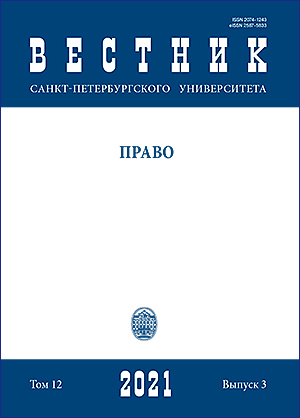The problems of violence against women in international law
DOI:
https://doi.org/10.21638/spbu14.2021.319Аннотация
The problems of violence against women and domestic violence were reflected in Goal No. 5 of the 2030 Agenda for Sustainable Development, which calls for gender equality and empowerment of women and girls while addressing such challenges as elimination of all forms of discrimination against women and girls; eradication of violence against women and girls in the public and private sphere, including human trafficking, sexual and other forms of exploitation; liquidation of all harmful practices, in particular forced marriages and female genital mutilation. In this article, the authors examine existing conventional and doctrinal definitions and qualifications of the terms “violence against women” and “domestic violence” in international law, explore international legal aspects of prevention and combatting violence against women and domestic violence, conduct a comprehensive analysis of a conceptual framework related to these offences, and present basic approaches to the concept of domestic violence. The authors also examine the link between two core international universal and regional legal acts in this field — Convention on the Elimination of all Forms of Discrimination against Women and Council of Europe Convention on preventing and combatting violence against women and domestic violence. The authors derive a new understanding of the due diligence principle (a well-known principle/standard in international law) with regard to violence against women and domestic violence issues, clarify its key components while codifying states’ main obligations in this sphere. In conclusion, the authors deduce that the questions of elimination of discrimination against women and eradication of violence against women can only be considered collectively, confirming the validity of the theory of a genderbased approach to the issue, which is adhered to by international human rights bodies.
Ключевые слова:
women’s rights, domestic violence, prevention of violence, Istanbul Convention, gender equality, discrimination, elimination of discrimination, due diligence
Скачивания
Библиографические ссылки
Загрузки
Опубликован
Как цитировать
Выпуск
Раздел
Лицензия
Статьи журнала «Вестник Санкт-Петербургского университета. Право» находятся в открытом доступе и распространяются в соответствии с условиями Лицензионного Договора с Санкт-Петербургским государственным университетом, который бесплатно предоставляет авторам неограниченное распространение и самостоятельное архивирование.






